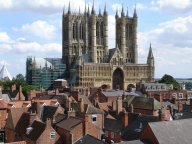 Lincoln Cathedral, one of the most important Medieval cathedrals in England if not Europe.
Lincoln Cathedral, one of the most important Medieval cathedrals in England if not Europe.
I have always held and am prepared against all evidence to maintain that the cathedral of Lincoln is out and out the most precious piece of architecture in the British Isles and roughly speaking worth any two other cathedrals we have. -- John Ruskin
When I face almighty God at my final judgement, as we all will, I can say I did try my best. I did try my best to protest. -- Sister Mary Michael
 Lincoln Cathedral, one of the most important Medieval cathedrals in England if not Europe.
Lincoln Cathedral, one of the most important Medieval cathedrals in England if not Europe.
Sitting on top of the hill, facing Lincoln Castle, Lincoln Cathedral is a prominent landmark visible for miles around.
For how long it will be visible from within Lincoln itself is a moot point when the local council keeps granting planning consent for ugly tower blocks which are ruining the skyline of this ancient city.
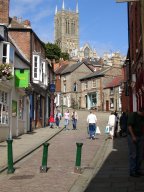 At the time of the Norman invasion, the diocese that was to become Lincoln was the largest diocese in medieval England, extending from the Humber to the Thames.
At the time of the Norman invasion, the diocese that was to become Lincoln was the largest diocese in medieval England, extending from the Humber to the Thames.
In 1072, William the Conqueror ordered that a Cathedral be built at Lincoln.
Remigius, a Benedictine monk and supporter of William the Conqueror at the Battle of Hastings in 1066, was the first Norman Bishop of the Diocese of Lincoln.
The cathedral of this diocese had been at Dorchester, near Oxford, that is until 1072 when William instructed that the Bishopric should be moved to Lincoln. Twenty years later, in 1092, the Cathedral was consecrated. Bishop Remigius died two days before the consecration.
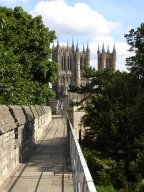 Lincoln Castle had already been built by William, located in the south-west corner of the old Roman upper city. The new cathedral, constructed of Lincolnshire oolitic limestone, was opposite the castle in the south-east corner of the old Roman city.
Lincoln Castle had already been built by William, located in the south-west corner of the old Roman upper city. The new cathedral, constructed of Lincolnshire oolitic limestone, was opposite the castle in the south-east corner of the old Roman city.
In 1141, or possibly earlier, the Cathedral was damaged by fire. Alexander 'the Magnificent' (Bishop of Lincoln, 1123-48) partially rebuilt the damaged Cathedral. Educated in Laon in northern France, Alexander travelled widely and was acquainted with the most advanced architecture of his day.
Henry of Huntingdon, who compiled his 'History of the English' at Alexander's request, states that the Bishop restored the Cathedral with such subtle workmanship that it was more beautiful than before, and second to none in England.
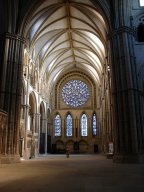 In 1185, an earthquake caused structural damage to Lincoln Cathedral. Saint Hugh (Bishop of Lincoln, 1186-1200) began reconstruction work in 1192.
In 1185, an earthquake caused structural damage to Lincoln Cathedral. Saint Hugh (Bishop of Lincoln, 1186-1200) began reconstruction work in 1192.
Henry II approved the election of Hugh of Avalon, a Carthusian monk and later canonized a saint, as Bishop of Lincoln in 1186.
Saint Hugh used the Gothic style, with pointed arches (rather than round ones), ribbed vaults and flying buttresses. This gave the elegance and sense of space we see today, and made possible larger windows (for stained glass) and larger roof spans.
Saint Hugh himself was said to have carried a hod to help with the building work, but he died in 1200, before his plans were complete, the great Transept and Nave were still unfinished.
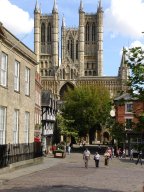 Lacking computer modelling, and little experience of this new architecture, mistakes were made and the central tower collapsed in 1237 or 1239.
Lacking computer modelling, and little experience of this new architecture, mistakes were made and the central tower collapsed in 1237 or 1239.
Work was started on a new tower, and in 1255 the Dean and Chapter successfully petitioned Henry III to allow them to take down part of the extended town wall to enlarge the Cathedral.
Hugh's rounded chapels were replaced with a larger and loftier square east end to provide more space for the increasing numbers of pilgrims venerating the saint's shrine.
The Angel Choir was consecrated in 1280.
Between 1307 and 1311 the central tower was raised to its present height.
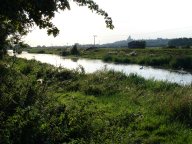 Around 1370 to 1400 the western towers were heightened.
Around 1370 to 1400 the western towers were heightened.
All three towers had spires until 1549 when the central tower's spire blew down.
The central tower rises to 83 m (271 feet) and remains the tallest cathedral tower in Europe without a spire. Prior to the collapse of the lead-encased wooden spire, with the spire, the Cathedral rose to a height of 160 m (525 feet), making it at the time the world's tallest building. It was the first building to exceed the height of the Great Pyramid of Giza. Until the collapse of the spire, the Cathedral remained the world's tallest structure for more than two centuries. Looking eastwards, the next highest point was the Ural Mountains in Russia.
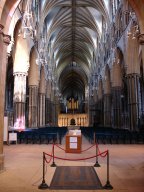 Within the Cathedral can be found a stone-gargoyle known as the Lincoln Imp.
Within the Cathedral can be found a stone-gargoyle known as the Lincoln Imp.
According to 14th-century legend, two mischievous creatures called imps were sent by Satan to do evil work on Earth. After causing mayhem elsewhere in Northern England the two imps headed to Lincoln Cathedral where they smashed tables and chairs and tripped up the Bishop. An angel appeared in the Angel Choir and ordered them to stop. One of the imps sat atop a stone pillar started throwing rocks at the angel whilst the other imp cowered under the broken tables and chairs. The angel turned the first imp to stone allowing the second imp escape.
The imp turned to stone, the Lincoln Imp, can still be found, frozen in stone, sitting atop his stone column in the Angel Choir.
An 1899 reproduction of the Lincoln Imp used to overlook the Front Quad of Lincoln College, Oxford. In 2000 it was transferred to the bar (Deep Hall) and another Imp was erected in the traditional position above the entrance to Hall. This has given rise to an Oxford expression: 'to look on someone like the Imp looks over Lincoln'. The Lincoln Imp has also given rise to the title of the college's undergraduate newspaper: The Lincoln Imp.
Lincoln City Football Club are known as The Imps. The Lincoln Imp is also the symbol of the City of Lincoln.
Lincoln Cathedral holds one of the four remaining copies of the original Magna Carta. Of the four remaining copies, one is held by Lincoln Cathedral, one by Salisbury Cathedral and two by the British Library.
Dating from the Middle Ages, Magna Carta is the most important document conferring democracy and civil rights. It is embedded in English Common Law and has been quoted and drawn on throughout the ages, from the US Constitution (especially the Bill of Rights) through to the UN Charter.
The Cathedral's copy is currently on loan to Lincoln Castle.
The highlight of the year at the Cathedral is the annual production in December of Handel's Messiah.
Lincoln Cathedral set standards for its time. Up until then, Norman Cathedrals were small, dark, with thick walls. No one can set foot within Lincoln Cathedral without having their breath taken away by it splendor.
Time though has taken its toll. Prior to the reformation, Lincoln contained more monasteries than any other diocese. All contributed to the upkeep of this magnificent building. At a stroke, Henry VIII did away with this income. By the late 1970s, many of gargoyles were almost unrecognisable, eaten away by acid rain.
In 2000, repairs were being carried out on the north side of the cathedral, including the re-building of one of the pinnacles. Work to the North Transept will culminate with the restoration of the Deanís Eye rose window. The Medieval glass will be returned to the all new stonework tracery. The work is scheduled to be completed by early 2006.
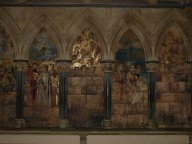 In recent years the Cathedral has been embroiled in scandal and controversy.
In recent years the Cathedral has been embroiled in scandal and controversy.
The Magna Carta was sent off to Australia. This was supposed to raise money for the Cathedral, instead the Cathedral ended up heavily in debt. The subsequent bloodletting and back-stabbing made the works of Anthony Trollope look like a child's picnic in comparison. And let us not forget, these are good Christian folk following the Lord's teachings.
August 2005, the Cathedral was used as a film set for the filming of Dan Brown's mega-selling novel The Da Vinci Code. The Chapter House was made to look like Westminster Abbey, Westminster Abbey having denied access for filming. The Cathedral received a reported £100,000. Sister Mary Michael, a Roman Catholic nun, mounted a solitary vigil outside in protest against what she saw as the blasphemous use of a Holy place to film a book which she considers to contain heresy.
Dan Green has jumped on the Da Vanci Code bandwagon with the publication of a book claiming the real links are with Lincoln Cathedral. Coincidentally publicised on 15 August 2005, when filming for The Da Vinci Code started at Lincoln Cathedral. [see The Lincoln Da Vinci Code]
According to Dan Green, the statue of Alfred Lord Tennyson (Tennyson being a leading Priory of Sion member), is a pointer to the location of where Mary Magdalene is buried. That location of course being Lincoln Cathedral.
The author is a contributor to Capturing Lincoln Cathedral, an illustrated guide to Lincoln Cathedral. Capturing the Cathedral was launched at the Moorland Centre, Tritton Road, Lincoln, Saturday 15 November 2008, where there was a display of some of the pictures used in the book. The book went on sale from mid-November 2008 at £9.99, part of a gift pack that includes a sturdy re-usable shopping bag and a free pass to Lincoln Cathedral. All monies raised from the sale of Capturing the Cathedral will go towards supporting the cathedral. Prints of pictures from the book may also be ordered. Prior to publication the book had the working title of Capturing the Cathedral.